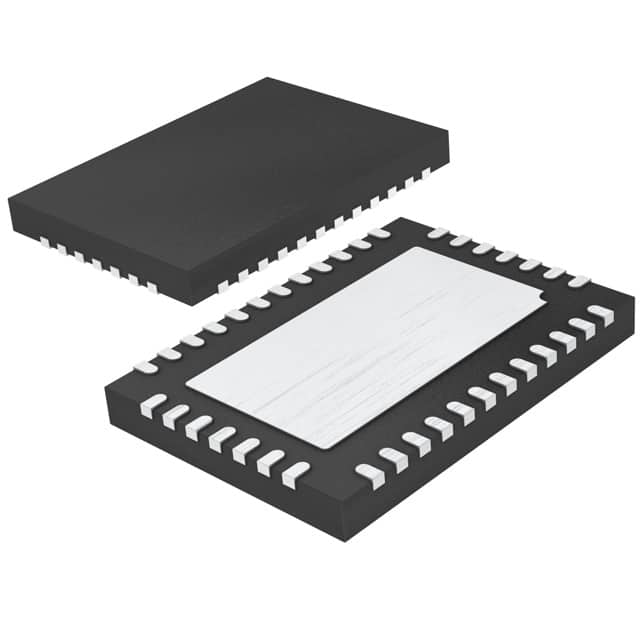Viz Specifikace pro podrobnosti o produktu.

LTC3829EUHF#TRPBF
Product Overview
- Category: Integrated Circuit (IC)
- Use: Power Management
- Characteristics: High Efficiency, Synchronous Step-Down DC/DC Controller
- Package: 38-Lead QFN (Quad Flat No-Lead)
- Essence: Regulates and controls the voltage in power management applications
- Packaging/Quantity: Tape & Reel, 2500 units per reel
Specifications
- Input Voltage Range: 4.5V to 60V
- Output Voltage Range: 0.8V to VIN
- Switching Frequency: Up to 750kHz
- Maximum Duty Cycle: 90%
- Quiescent Current: 50µA
- Operating Temperature Range: -40°C to 125°C
Detailed Pin Configuration
- VIN: Input Voltage
- GND: Ground
- SS/TRK: Soft-Start/Tracking Control
- FB: Feedback Voltage
- SYNC/MODE: External Clock Synchronization/Operating Mode Selection
- VCC: Supply Voltage for Internal Circuitry
- PGND: Power Ground
- SW: Switch Node Connection
- BOOT: Bootstrap Capacitor Connection
- COMP: Compensation Node
(Note: The pin configuration includes additional pins not listed here.)
Functional Features
- High Efficiency: The LTC3829EUHF#TRPBF offers high efficiency power conversion, minimizing energy loss.
- Synchronous Step-Down: It provides synchronous step-down DC/DC conversion, ensuring accurate voltage regulation.
- Soft-Start/Tracking Control: The soft-start feature allows gradual ramp-up of the output voltage, preventing excessive current flow during startup.
- External Clock Synchronization: The device can be synchronized with an external clock signal for precise timing control.
- Operating Mode Selection: The operating mode can be selected based on the application requirements, allowing flexibility in power management.
Advantages and Disadvantages
Advantages: - High efficiency leads to reduced power consumption. - Accurate voltage regulation ensures stable power supply. - Soft-start feature prevents excessive current flow during startup. - External clock synchronization allows precise timing control.
Disadvantages: - Limited input voltage range (4.5V to 60V). - Maximum duty cycle of 90% may not be suitable for certain applications.
Working Principles
The LTC3829EUHF#TRPBF is a synchronous step-down DC/DC controller that regulates the output voltage based on the input voltage and feedback voltage. It utilizes high-frequency switching to efficiently convert the input voltage to the desired output voltage. The soft-start feature gradually ramps up the output voltage to prevent excessive current flow during startup. The device can operate in different modes depending on the application requirements, providing flexibility in power management.
Detailed Application Field Plans
The LTC3829EUHF#TRPBF is commonly used in various power management applications, including:
- Industrial Equipment: Powering motors, sensors, and control systems in industrial machinery.
- Automotive Electronics: Regulating voltage for automotive components such as infotainment systems, lighting, and engine control units.
- Telecommunications: Providing stable power supply for telecom infrastructure equipment like base stations and routers.
- Renewable Energy Systems: Controlling voltage in solar panels, wind turbines, and energy storage systems.
- Consumer Electronics: Powering portable devices, home appliances, and audio/video equipment.
Detailed and Complete Alternative Models
- LTC3810EUHF#TRPBF
- LTC3830EUHF#TRPBF
- LTC3840EUHF#TRPBF
- LTC3850EUHF#TRPBF
- LTC3860EUHF#TRPBF
(Note: The list of alternative models can be expanded based on the specific requirements and availability in the market.)
This entry provides an overview of the LTC3829EUHF#TRPBF, a high-efficiency synchronous step-down DC/DC controller. It includes information about its category, use, characteristics, package, specifications, pin configuration, functional features, advantages and disadvantages, working principles, application field plans, and alternative models.
Seznam 10 běžných otázek a odpovědí souvisejících s aplikací LTC3829EUHF#TRPBF v technických řešeních
Sure! Here are 10 common questions and answers related to the application of LTC3829EUHF#TRPBF in technical solutions:
Q: What is LTC3829EUHF#TRPBF? A: LTC3829EUHF#TRPBF is a specific model number of a high-performance synchronous step-down DC/DC controller IC.
Q: What are the key features of LTC3829EUHF#TRPBF? A: Some key features include wide input voltage range, high efficiency, adjustable frequency, and integrated protection features.
Q: What is the typical application of LTC3829EUHF#TRPBF? A: LTC3829EUHF#TRPBF is commonly used in various power supply applications, such as telecom, industrial, automotive, and distributed power systems.
Q: What is the maximum input voltage supported by LTC3829EUHF#TRPBF? A: The maximum input voltage supported by LTC3829EUHF#TRPBF is typically around 60V.
Q: Can LTC3829EUHF#TRPBF operate with both high-side and low-side MOSFETs? A: Yes, LTC3829EUHF#TRPBF can operate with both high-side and low-side N-channel MOSFETs.
Q: Does LTC3829EUHF#TRPBF have built-in protection features? A: Yes, LTC3829EUHF#TRPBF has various built-in protection features like overvoltage protection, overcurrent protection, and thermal shutdown.
Q: What is the maximum output current that LTC3829EUHF#TRPBF can handle? A: The maximum output current depends on the external components used but can typically go up to several amps.
Q: Can LTC3829EUHF#TRPBF operate in a wide temperature range? A: Yes, LTC3829EUHF#TRPBF is designed to operate in a wide temperature range, typically from -40°C to 125°C.
Q: Does LTC3829EUHF#TRPBF require any external compensation components? A: Yes, LTC3829EUHF#TRPBF requires external compensation components for stability and loop control.
Q: Is there any evaluation board available for LTC3829EUHF#TRPBF? A: Yes, Linear Technology (now part of Analog Devices) provides an evaluation board for LTC3829EUHF#TRPBF, which can be used for testing and prototyping purposes.
Please note that the answers provided here are general and may vary depending on specific application requirements. It's always recommended to refer to the datasheet and consult with the manufacturer or technical support for accurate and detailed information.

